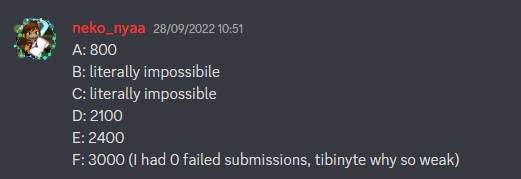Hope you liked the problems!
This is my second contest on Codeforces, inspiring coordination has been done for the last several months, cannot wait until the third round is released!
| Tester | A | B | C | D | E | F |
|---|---|---|---|---|---|---|
| xiaoziya | 900 | 1000 | 1400 | 1800 | 2100 | 3000 |
| feecle6418 | 900 | 1200 | 1400 | 1700 | 2200 | 2900 |
| ntherner | 800 | 1100 | 1550 | 1900 | 2200 | - |
| 6aren | 800 | 1200 | - | 2000 | 2200 | - |
| neko_nyaaaaaaaaaaaaaaaaa | 800 | - | - | 2100 | 2400 | 3000 |
| tibinyte2006 | 800 | 1100 | 1550 | 1800 | 2100 | 2550 |





















Author: thanhchauns2
Try to brute force for $$$k < 50$$$. Do you see anything suspicious?
Now try to brute force from $$$k - 1$$$ to $$$0$$$ for large numbers.
1768A- Greatest Convex
Is $$$x = k - 1$$$ always suitable?
The answer is yes, as $$$x! + (x - 1)! = (x - 1)! \times (x + 1) = ((k - 1) - 1)! \times ((k - 1) + 1) = (k - 2)! \times (k)$$$, which is clearly a multiple of $$$k$$$.
Therefore, $$$x = k - 1$$$ is the answer.
Time complexity: $$$\mathcal{O}(1)$$$
answer = [print(int(input()) - 1) for testcase in range(int(input()))]
Author: Vladithur Preparation: Vladithur and Alexdat2000
Try to have the last $$$k + 1$$$ numbers sorted.
Fix some set of numbers (not necessary sorted) of size $$$w$$$ and don't choose them in the operation. Try to have the last $$$n - w$$$ numbers sorted.
Fix the set of numbers $$$1,2,3,\ldots$$$
#include <bits/stdc++.h>
#define all(x) (x).begin(), (x).end()
#define allr(x) (x).rbegin(), (x).rend()
#define gsize(x) (int)((x).size())
const char nl = '\n';
typedef long long ll;
typedef long double ld;
using namespace std;
void solve() {
int n, k;
cin >> n >> k;
vector<int> p(n);
for (int i = 0; i < n; i++) cin >> p[i];
int c_v = 1;
for (int i = 0; i < n; i++) {
if (p[i] == c_v) c_v++;
}
cout << (n - c_v + k) / k << nl;
}
int main() {
ios::sync_with_stdio(0); cin.tie(0);
int T;
cin >> T;
while (T--) solve();
}
Author: thanhchauns2
How many times a unique number can appear in the array $$$a$$$?
Can there be two numbers $$$1$$$ in $$$a$$$? What is the conclusion?
If you sort the array, which rules should the new array satisfy? Given the array $$$[1,2,2 ]$$$, is there any answer for this case?
Which element should you construct first?
1768C- Elemental Decompress
Two cases produce no answers:
One element appears more than twice in $$$a$$$.
After sorting, there is some index that $$$a[i] < i$$$ ($$$1$$$-indexed).
Consider there is some index that $$$a[i] <i$$$, then both $$$p[i] < i$$$ and $$$q[i] < i$$$ must satisfy. This is also true for the first $$$i - 1$$$ index, so the numbers that are smaller than $$$i$$$ in both $$$p$$$ and $$$q$$$ are $$$(i - 1) \times 2 + 2 = i * 2$$$. This is a contradiction.
Otherwise, solutions always exist. One method is to constructively attach each element in $$$a$$$ to $$$p$$$ or $$$q$$$:
Traverse from the biggest element to the smallest in $$$a$$$, if that number haven't appeared in $$$p$$$ then attach it to $$$p$$$, otherwise attach it to $$$q$$$.
Traverse from the biggest element to the smallest in $$$a$$$ again, if we attached it to $$$p$$$, find the biggest number that did not appear in $$$q$$$ and attach to $$$q$$$, vice versa.
A naive solution requires the $$$O(n^2)$$$ method to solve. We can reduce to $$$O(n \log n)$$$ by sorting elements in $$$a$$$ as pairs <element, index>.
Time complexity: $$$\mathcal{O}(n \log(n))$$$
#include <bits/stdc++.h>
using namespace std;
const int N = 200005;
int n;
int a[N], b[N], c[N], ra[N], rb[N];
void out()
{
for (int i = 0; i < n; i++)
{
cout << a[i] << ' ';
}
cout << '\n';
for (int i = 0; i < n; i++)
{
cout << b[i] << ' ';
}
cout << '\n';
}
void solve()
{
cin >> n;
vector<pair<int, int> > V;
for (int i = 0; i < n; i++)
{
cin >> c[i];
a[i] = b[i] = 0;
ra[i + 1] = rb[i + 1] = 1;
V.push_back(make_pair(c[i], i));
}
sort(V.rbegin(), V.rend());
for (int i = 0; i < n; i++)
{
int k = V[i].second;
if (ra[c[k]] == 1) a[k] = c[k], ra[c[k]]--;
else b[k] = c[k], rb[c[k]]--;
}
int r1 = n, r2 = n;
for (int i = 0; i < n; i++)
{
int k = V[i].second;
if (a[k] == 0)
{
while (ra[r1] == 0) r1--;
ra[r1]--;
if (r1 > b[k])
{
cout << "NO" << '\n';
return;
}
a[k] = r1--;
}
else
{
while (rb[r2] == 0) r2--;
rb[r2]--;
if (r2 > a[k])
{
cout << "NO" << '\n';
return;
}
b[k] = r2--;
}
}
for (int i = 1; i <= n; i++)
{
if (ra[i] != 0 || rb[i] != 0)
{
cout << "NO" << '\n';
return;
}
}
cout << "YES" << '\n';
out();
}
int main(int argc, char* argv[])
{
ios_base::sync_with_stdio(false); cin.tie(0); cout.tie(0);
int t;
cin >> t;
while(t--)
solve();
}
There is actually a $$$O(n)$$$ solution to this problem.

If there are at least $$$k > 3$$$ positions $$$i_1, i_2, \ldots, i_k$$$ that $$$a[i_1] = a[i_2] = \ldots = a[i_k]$$$ then there is no solution.
Since we need the condition $$$a[i] = max(p[i], q[i])$$$, hence $$$p[i] = a[i]$$$ or/and $$$q[i] = a[i]$$$.
If there are already $$$p[i_1] = a[i_1]$$$ and $$$q[i_2] = a[i_2]$$$ then we don't have another number equal to $$$a[i_k]$$$ because $$$p[]$$$ and $$$q[]$$$ are two permutations (each number must appear exactly once).
/// Storing position of each a[i]
vector<vector<int> > b(n + 1);
for (int i = 1; i <= n; ++i) {
b[a[i]].push_back(i);
/// max(p[i], q[i]) = a[i] so either p[i] = a[i] or/and q[i] = a[i]
/// so if the number appear the third time or more, then "NO"
if (b[a[i]].size() >= 3) {
cout << "NO\n";
return 0;
}
}
Since we have the $$$max()$$$ function, we need to use the larger value firsts.
If we iterate from the smallest value to the top, there will be scenarios where all the remaining positions $$$i$$$ will result in $$$max(p[i], q[i]) \geq a[i]$$$ because you don't have enough smaller integers.
So for each $$$x = n \rightarrow 1$$$ (iterating from the largest element to the smallest element), we check for each position $$$i$$$ that $$$a_i = x$$$, then assign $$$p[i] := a[i]$$$ if $$$a[i]$$$ didn't appear in permutation $$$p[]$$$, otherwise assign $$$q[i] := a[i]$$$.
/// Initialize permutation p[1..n], q[1..n]
vector<int> p(n + 1, -1), q(n + 1, -1);
/// Initialize permutation position, fp[p[i]] = i, fq[q[i]] = i
vector<int> fp(n + 1, -1), fq(n + 1, -1);
for (int x = n; x >= 1; --x) {
for (int i : b[x]) {
/// Because of max(), we must save up the smaller value
/// So we assign p[i] or q[i] by x, one by one from x large -> small
if (fp[x] == -1) p[fp[x] = i] = x;
else if (fq[x] == -1) q[fq[x] = i] = x;
}
}
We fill the remaining integers that wasn't used, from the largest to the smallest.
We use $$$vp$$$ as the largest integer not used in permutation $$$p[1..n]$$$.
We use $$$vq$$$ as the largest integer not used in permutation $$$q[1..n]$$$.
Then for each of the value $$$x = n \rightarrow 1$$$, we assign to $$$p[i], q[i]$$$ that was not used.
for (int x = n, vp = n, vq = n; x >= 1; --x) {
for (int i : b[x]) {
/// Assign the remaining integers
while (fp[vp] != -1) --vp;
while (fq[vq] != -1) --vq;
if (p[i] == -1 && vp > 0) p[fp[vp] = i] = vp;
if (q[i] == -1 && vq > 0) q[fq[vq] = i] = vq;
}
}
Check if the permutation $$$p[]$$$ and $$$q[]$$$ satisfied the solution, if it didnt then output "NO", otherwise output "YES" and the two permutations: $$$p[1..n]$$$ and $$$q[1..n]$$$.
Just iterate through each element as normal.
for (int i = 1; i <= n; ++i) {
if (max(p[i], q[i]) != a[i]) {
/// Statement condition is not satisfied
cout << "NO\n";
return 0;
}
}
/// Output the answer
cout << "YES\n";
for (int i = 1; i <= n; ++i) cout << p[i] << " "; cout << "\n";
for (int i = 1; i <= n; ++i) cout << q[i] << " "; cout << "\n";
There is also another way that you can skip testing if $$$max(p[i], q[i]) = a[i])$$$ is correct.
But the proof is a bit harder to understand, so I prefer using this code instead.
#include <iostream>
#include <vector>
using namespace std;
int query()
{
/// Input number of element
int n;
cin >> n;
/// Input the array a[1..n]
vector<int> a(n + 1);
for (int i = 1; i <= n; ++i)
cin >> a[i];
/// Storing position of each a[i]
vector<vector<int> > b(n + 1);
for (int i = 1; i <= n; ++i) {
b[a[i]].push_back(i);
/// max(p[i], q[i]) = a[i] so either p[i] = a[i] or/and q[i] = a[i]
/// so if the number appear the third time or more, then "NO"
if (b[a[i]].size() >= 3) {
cout << "NO\n";
return 0;
}
}
/// Initialize permutation p[1..n], q[1..n]
vector<int> p(n + 1, -1), q(n + 1, -1);
/// Initialize permutation position, fp[p[i]] = i, fq[q[i]] = i
vector<int> fp(n + 1, -1), fq(n + 1, -1);
for (int x = n; x >= 1; --x) {
for (int i : b[x]) {
/// Because of max(), we must save up the larger value
/// So we assign p[i] or q[i] by x, one by one from x large -> small
if (fp[x] == -1) p[fp[x] = i] = x;
else if (fq[x] == -1) q[fq[x] = i] = x;
}
}
for (int x = n, vp = n, vq = n; x >= 1; --x) {
for (int i : b[x]) {
/// Assign the remaining integers
while (fp[vp] != -1) --vp;
while (fq[vq] != -1) --vq;
if (p[i] == -1 && vp > 0) p[fp[vp] = i] = vp;
if (q[i] == -1 && vq > 0) q[fq[vq] = i] = vq;
}
}
for (int i = 1; i <= n; ++i) {
if (max(p[i], q[i]) != a[i]) {
/// Statement condition is not satisfied
cout << "NO\n";
return 0;
}
}
/// Output the answer
cout << "YES\n";
for (int i = 1; i <= n; ++i) cout << p[i] << " "; cout << "\n";
for (int i = 1; i <= n; ++i) cout << q[i] << " "; cout << "\n";
return 0;
}
signed main()
{
ios::sync_with_stdio(NULL);
cin.tie(NULL);
int q = 1; /// If there is no multiquery
cin >> q; /// then comment this
while (q-->0)
{
/// For each query
query();
}
return 0;
}
Author: Vladithur Preparation: Vladithur and Alexdat2000
There are $$$n - 1$$$ permutations of length $$$n$$$ that have exactly one inversion in them.
This problem is similar to finding the minimum number of swaps needed to sort a permutation.
Try looking at the permutation like a graph.
Try to find the number of cycles in each of the $$$n - 1$$$ graphs.
#include <bits/stdc++.h>
#define all(x) (x).begin(), (x).end()
#define allr(x) (x).rbegin(), (x).rend()
#define gsize(x) (int)((x).size())
const char nl = '\n';
typedef long long ll;
typedef long double ld;
using namespace std;
void solve() {
int n;
cin >> n;
vector<int> p(n);
for (int i = 0; i < n; i++) {
cin >> p[i]; p[i]--;
}
int ind = 1, ans = 0;
vector<int> comp(n, 0);
for (int i = 0; i < n; i++) {
if (comp[i]) continue;
{
int v = i;
while (comp[v] == 0) {
comp[v] = ind;
v = p[v];
ans++;
}
ind++; ans--;
}
}
for (int i = 0; i < n - 1; i++) {
if (comp[i] == comp[i + 1]) {
cout << ans - 1 << nl;
return;
}
}
cout << ans + 1 << nl;
}
int main() {
ios::sync_with_stdio(0); cin.tie(0);
int T;
cin >> T;
while (T--) solve();
}
Author: thanhchauns2
Given a fixed permutation, how many operations do we need to sort it?
Keep in mind there is one already sorted permutation that doesn't need to be sorted.
What if there is exactly $$$1$$$ number in the range $$$[n + 1, 2n]$$$ that appears in the first $$$n$$$ numbers?
This is not really a hint, fft solutions exist, but we made sure most of them cannot pass.
1768E- Partial Sorting
We need at most $$$3$$$ operations to sort the permutation: $$$1 -> 2 -> 1$$$
- For $$$f(p) = 0$$$, there is only one case: the initially sorted permutation.
return (38912738912739811 & 1)
- For $$$f(p) \leq 1$$$, this scenario appears when the first $$$n$$$ numbers or the last $$$n$$$ numbers are in the right places.
Both cases have $$$n$$$ fixed positions, so there will be $$$(2n!)$$$ permutations in each case.
Intersection: since both cases share the $$$n$$$ middle elements, $$$(n!)$$$ permutation will appear in both cases.
So there will be $$$2 \times (2n!) - (n!)$$$ such permutations.
- For $$$f(p) \leq 2$$$, this scenario appears when the smallest $$$n$$$ elements' positions are in range $$$[1, 2n]$$$, or the largest $$$n$$$ numbers' positions are in range $$$[n + 1, 3n]$$$.
If the smallest $$$n$$$ elements are all in position from $$$1$$$ to $$$2n$$$, then:
There are $$$C_{2n}^{n}$$$ ways to choose $$$n$$$ positions for these numbers.
For each way to choose these positions, there are $$$n!$$$ ways to choose the position for the smallest $$$n$$$ numbers, and $$$2n!$$$ ways for the rest.
The total number of valid permuations are: $$$C_{2n}^{n} \times n! \times 2n!$$$
If the largest $$$n$$$ elements are all in position from $$$n + 1$$$ to $$$3n$$$, we do the same calculation.
Intersection: intersection appears when the first $$$n$$$ numbers are all in range $$$[1, 2n]$$$ and the last $$$n$$$ numbers are all in range $$$[n + 1, 3n]$$$.
Let intersection = 0
Let's talk about the numbers in range $$$[n + 1, 2n]$$$. There are $$$n$$$ such numbers.
. Imagine there are EXACTLY $$$i = 0$$$ numbers in this range that appear in the first $$$n$$$ numbers. So:
In the first $$$n$$$ numbers there are $$$n$$$ numbers in range $$$[1, n]$$$. There are $$$C_{n}^{n - 0} \times n!$$$ cases.
In the first $$$n$$$ numbers there are $$$0$$$ numbers in range $$$[n + 1, 2n]$$$. There are $$$C_{n}^{0} \times n!$$$ cases.
In the last $$$n$$$ numbers there are $$$n$$$ numbers in range $$$[n + 1, 3n]$$$, we have used $$$0$$$ numbers for the first n numbers. There are $$$C_{2n - 0}^{n} \times n!$$$ cases.
Then we have: intersection += $$$C_{n}^{n - 0} \times C_{n}^{0} \times C_{2n - 0}^{n} \times n! \times n! \times n!$$$
After convert $$$0$$$ to $$$i$$$, we have intersection += $$$C_{n}^{n - i} \times C_{n}^{i} \times C_{2n - i}^{n} \times n! \times n! \times n!$$$
How about there is EXACTLY $$$i = 1$$$ number in range $$$[n + 1, 2n]$$$ appearing in the first $$$n$$$ numbers?
In the first $$$n$$$ numbers there are $$$n - 1$$$ numbers in range $$$[1, n]$$$. There are $$$C_{n}^{n - 1} \times n!$$$ cases.
In the first $$$n$$$ numbers there are $$$1$$$ numbers in range $$$[n + 1, 2n]$$$. There are $$$C_{n}^{1} \times n!$$$ cases.
In the last $$$n$$$ numbers there are $$$n$$$ numbers in range $$$[n + 1, 3n]$$$, we have used $$$1$$$ numbers for the first $$$n$$$ numbers. There are $$$C_{2n - 1}^{n} \times n!$$$ cases.
Then we have: intersection += $$$C_{n}^{n - 1} \times C_{n}^{1} \times C_{2n - 1}^{n} \times n! \times n! \times n!$$$
After convert $$$1$$$ to $$$i$$$, we have intersection += $$$C_{n}^{n - i} \times C_{n}^{i} \times C_{2n - i}^{n} \times n! \times n! \times n!$$$
We do the same thing with remaining cases, all the way up to $$$i = n$$$.
The number of intersections will be equal to: $$$ \sum_{i = 0}^{n} C_{n}^{n - i} \times C_{n}^{i} \times C_{2n - i}^{n} \times n! \times n! \times n! $$$
So, the answer will be $$$2 \times C_{2n}^{n} \times n! \times 2n! - \sum_{i = 0}^{n} C_{n}^{n - i} \times C_{n}^{i} \times C_{2n - i}^{n} \times n! \times n! \times n!$$$
- For $$$f(p) \leq 3$$$, it will be the count of all valid permutations.
return __factorial(n * __number_of_sides_of_a_triangle)
Time complexity: $$$\mathcal{O}(n)$$$
#include <bits/stdc++.h>
using namespace std;
long long n, M;
long long frac[3000005], inv[3000005];
long long powermod(long long a, long long b, long long m)
{
if (b == 0) return 1;
unsigned long long k = powermod(a, b / 2, m);
k = k * k;
k %= m;
if (b & 1) k = (k * a) % m;
return k;
}
void Ready()
{
frac[0] = 1;
inv[0] = 1;
for (int i = 1; i <= 3000000; i++)
{
frac[i] = (frac[i - 1] * i) % M;
}
inv[3000000] = powermod(frac[3000000], M - 2, M);
for (int i = 3000000; i > 0; i--)
{
inv[i - 1] = (inv[i] * i) % M;
}
}
long long C(long long n, long long k)
{
return ((frac[n] * inv[k]) % M * inv[n - k]) % M;
}
int main()
{
cin >> n >> M;
Ready();
long long ans[4]{};
// X = 0
ans[0] = 1;
// X = 1
ans[1] = 2 * frac[2 * n] - frac[n] - ans[0] + M + M;
ans[1] %= M;
// X = 2
ans[2] = frac[2 * n];
ans[2] = ans[2] * C(2 *n, n) % M;
ans[2] = ans[2] * frac[n] % M;
ans[2] = ans[2] * 2 % M;
for (int i = 0; i <= n; i++)
{
int sub = C(n, i);
sub = sub * C(n, n - i) % M;
sub = sub * C(2 * n - i, n) % M;
sub = sub * frac[n] % M;
sub = sub * frac[n] % M;
sub = sub * frac[n] % M;
ans[2] = (ans[2] - sub + M) % M;
}
ans[2] = (ans[2] - ans[1] + M) % M;
ans[2] = (ans[2] - ans[0] + M) % M;
// X = 3
ans[3] = frac[3 * n];
ans[3] = (ans[3] - ans[2] + M) % M;
ans[3] = (ans[3] - ans[1] + M) % M;
ans[3] = (ans[3] - ans[0] + M) % M;
long long answer = ans[1] + 2 * ans[2] + 3 * ans[3];
answer %= M;
cout << answer << endl;
}
Author: Vladithur Preparation: Vladithur and Alexdat2000
Use dynamic programming.
$$$a_i \le n$$$
Compare $$$\min(a_i \ldots a_j) \cdot (j - i)^2$$$ with $$$n \cdot (j - i)$$$.
Compare $$$\min(a_i \ldots a_j) \cdot (j - i)^2$$$ with $$$\min(a_i \ldots a_k) \cdot (k - i)^2 + \min(a_k \ldots a_j) \cdot (j - k)^2$$$ for some $$$i < k < j$$$.
Two cases: $$$\min(a_i \ldots a_j) \ge \sqrt{n}$$$ and $$$\min(a_i \ldots a_j) < \sqrt{n}$$$.
Split $$$\min(a_i \ldots a_j) < \sqrt{n}$$$ into two more cases: $$$\min(a_i \ldots a_j) = a_i$$$ and $$$\min(a_i \ldots a_j) = a_j$$$.
#include <bits/stdc++.h>
#define all(x) (x).begin(), (x).end()
#define allr(x) (x).rbegin(), (x).rend()
#define gsize(x) (int)((x).size())
const char nl = '\n';
typedef long long ll;
typedef long double ld;
using namespace std;
const int K = 650;
int main() {
ios::sync_with_stdio(0); cin.tie(0);
int n;
cin >> n;
vector<ll> a(n);
for (int i = 0; i < n; i++) cin >> a[i];
vector<ll> dp(n, 1e18);
dp[0] = 0;
vector<int> st = {0};
for (int i = 1; i < n; i++) {
// Case 1
{
ll mi = a[i];
for (int j = i - 1; j >= max(0, i - K); j--) {
mi = min(mi, a[j]);
dp[i] = min(dp[i], dp[j] + mi * (i - j) * (i - j));
}
}
// Case 2
if (a[i] <= K) {
for (int j = i - 1; j >= 0; j--) {
dp[i] = min(dp[i], dp[j] + a[i] * (i - j) * (i - j));
if (a[j] <= a[i]) break;
}
}
// Case 3
{
for (int j: st) {
dp[i] = min(dp[i], dp[j] + a[j] * (i - j) * (i - j));
}
if (a[i] <= K) {
while (!st.empty() && a[st.back()] >= a[i]) {
st.pop_back();
}
st.push_back(i);
}
}
}
for (int i = 0; i < n; i++) cout << dp[i] << ' ';
cout << endl;
}
#include <iostream>
#include <vector>
#include <chrono>
#include <random>
#include <cassert>
std::mt19937 rng((int) std::chrono::steady_clock::now().time_since_epoch().count());
int main() {
std::ios_base::sync_with_stdio(false); std::cin.tie(NULL);
int n;
std::cin >> n;
std::vector<int> a(n);
for(int i = 0; i < n; i++) {
std::cin >> a[i];
}
std::vector<long long> dp(n, 1e18);
dp[0] = 0;
for(int i = 0; i < n; i++) {
int dist = n / a[i] + 1;
// take from behind
for(int j = i-1; j >= 0 && i-j <= dist; j--) {
dp[i] = std::min(dp[i], dp[j] + (long long) a[i] * (i - j) * (i - j));
if(a[j] <= a[i]) break;
}
// propagate forward
for(int j = i+1; j < n && j-i <= dist; j++) {
dp[j] = std::min(dp[j], dp[i] + (long long) a[i] * (i - j) * (i - j));
if(a[j] <= a[i]) break;
}
std::cout << dp[i] << (i + 1 == n ? '\n' : ' ');
}
}










From SPyofgame during the contest:
yeah, bro
First time ranked top100 in div2. Hope for no FST!
Update: It's frustrating that I always get downvoted and don't know the reason
Why so many downvotes? This is bully!
Giving you Downvote to motivate your frustration to frustrate you more....
Permutation Forces !
Delivered so fast..
2023 should not be a permutation
love the fast editorial
I got the idea for C but not able to implement it. :-)..
mee too
Can anybody help me to figure why this code is not accepted??? https://codeforces.me/contest/1768/submission/188117185
Do not paste the code in the comment.
ok thanks to indicate I have removed the code
Write codes in spoiler or only provide the link as you have provided here, as it becomes quite difficult to read this way
ok I will see to it from next time
Although pasting code directly is awful, I've checked your code in the link. In fact, the most part of your code is right except one point: when doing
you need to check if (*it1>*it2). If not, there's no solution because max(p[i],q[i]) will be *it2.
ok!!!!!!!! Right I will think harder next time to not miss something like this
You know what it feels like when you finish E when there're only 10 sec left but fail to submit the code before the last second?
dude same, i was literally about to finish it, rip 2250
Not my first time actually :3
Sorry, never solved D.:(
Amazing , was very curious for fast tutorial especially for Problem C.
Hi guys! although the editorial they've provided is great! still if you want a video format editorial you can find it here
PermutationForces?)
"it took me 2 minutes to actually prove the solution"
and it took me probably a minute and a half (may be inaccurate) to find out that $$$k! + (k-1)! = (k-1)!(k+1)$$$ and the rest of the proof is just factoradic blah blah
i submitted 6 unsuccessful attempts so i lost 300 points in the contest? if there is a maximum amount u can lose, how much is it?
No matter how many times you submit for a problem, you get at least 30% of points if you solved it finally.
If you have wrong submission for problem $$$X$$$ you will get 50 points less then you usually would on that problem.
If you have few wrong submissions on a problem you didn't solve, you won't lose any points.
Why so tight TL on E.
You can calculate the inverses of factorials more efficiently by calculating them from n to 0.
OK! thanks
Actually there's O(n) solution for C. We don't need to do any sorting. We can just count the occurence of 1-n and let occ[i]= the times i appeared in array a[]. if there's some occ[i]>2 there's no answer. Then we build two list more[] and less[]. We iterate for i from 1 to n, if occ[i]==0 we add it to less[], if occ[i]==2 we add it to more[]. since 0<=occ[i]<=2, the size of more[] and less[] will be equal. then we iterate for more[i] and less[i] reversely, if some more[i]<less[i] there's no answer. If there's no such i, we can construct p and q: for each pair of more[i] and less[i], let's call they M and L, and j = the smaller index where a[j]==M, k = the larger index where a[k]==M, we let p[j]=q[k]=M, q[j]=p[k]=L. For those j which a[j] appear only once, we just let p[j]=q[j]=a[j].
My submission:188076704
Yah nice solution :3
It's a well know fact that n — cycles is the minimum number of swaps to get 1, 2, ..., n.
Can someone explains me this ? and where is this well know ?
each cycle of length $$$l$$$ needs $$$l-1$$$ swaps to be sorted, you can try it yourself
nice E...stuck in case f=2 too longgg...
codeforces!
F is so fantastic! It's hard to solve, but not hard to understand the solution.
Can we see pretest after the contest. This submission failed pretest 2: Link
Pretest 2 is every combination possible for $$$n \leq 5$$$, you can write a code then generate pretest 2 yourself.
I'm looking for problem like today problem D and C. Specially problems on arrays that can be transformed into problems on graph.
Example 1 : You want to obtains array b from array a with some specific operation
Example 2 : You want to obtains array a and b from array c with some specific operation
Example 3 : optimizing or computing something on an array after some operation (This turns out to be somewhat related to paths on a graph ...)
In almost all the solutions we need to build some graph with specific edges. I don't know how to tackle that kind of problems.
F let me feel :F
D let me feel :D
I got o(n) for C lolol. 188093045
nvm its o(nlogn)
sort(putP.rbegin(), putP.rend()) It is minimum O(n logn)
Since I didn't implement, please point out if I did anything wrong on F, or if my approach would TLE.
After the monotonic stack observation, it should be possible to use a kinetic tournament on quadratics to handle cases with $$$min(a_i,\ldots, a_j)=a_i$$$ and li-chao tree or another kinetic tournament otherwise. The time complexity would be $$$O(n2^{\alpha(n)}\log^2(n))$$$.
I cannot understand the editorial of Problem C, which says there are (i — 2)*2 + 2 numbers. (there can be a repetition of numbers in p and q) also, why is this a contradiction?
What do you mean by "there can be a repetition of numbers in p and q"? $$$p$$$ and $$$q$$$ are permutations, they can't have any repeated numbers (although the same numbers that appear in $$$p$$$ also appear in $$$q$$$ since they are both permutations from $$$1$$$ to $$$n$$$).
In the editorial of problem E, when calculating the intersection for f(p)<=2, the sum should be sum(i=0...n) instead of sum(i=1...n). Please fix it
Yes it is, I fixed the editorial.
I had a slightly different $$$O(n)$$$ 188071468 from the one given for Problem C.
No CHT solution for F? That's very interesting.
It is possible to use it to solve the second case, but you'll have to squeeze it into the tight ML.
It is a well know fact that n−cycles is the minimum number of swaps needed to get the permutation 1,2,3,…,n from our initial one (in other words, to sort it).
Can anyone Please provide me the material where i can see this tutorial and learn . Thank You!!.
Someone mentioned it. Each cycle of length $$$l$$$ needs $$$l - 1$$$ swaps to sort.
Thanks, i got it now .
Can anyone explain E in a simpler way ? I am having a hard time understanding the editorial..
I modified it a little bit, maybe you'll find it easier to read.
Ugh my solution to C FST'd due to TLE can someone tell me why :(( https://codeforces.me/contest/1768/submission/188118022
Here is the reason -> https://codeforces.me/blog/entry/48793
:((((( oh no I didn't know
Well, U know it now.
Is it possible for you to make a report on the channels that download solutions on YouTube during the contest? Very thanks.<3
Maybe I missed something, but why there is O(n*sqrt(n)) with [n, n-1, n-2, ..., 1] array? Or any similar.
In this subcase, $$$a_j < \sqrt{A}$$$.
I think this time aj is smaller than sqrtA, consider all the cases of such j, the total compexity of the j with same value will not exceed n, so the overall complexity will not exceed..nsqrtA sorry my poor english
⌊n−w+k−1⌋/k
could you please eplain me why we add K-1 with n-w ? .
so as to do the ceil operation otherwise it's by default floor operation as the integer division truncates anything after the decimal point
I'm having a hard time trying to understand the intersection formula for $$$f(p) \le 2$$$ from E's editorial. Can you please proofread the 'sketch and calculation' spoiler and fix some mistakes/typos?
I modified it a little bit, maybe you'll find it easier to read.
I mean I read for example this sentence:
In the last $$$n$$$ numbers there are $$$n$$$ numbers in range $$$[n+1,2n]$$$, we have used $$$1$$$ numbers for the first $$$n$$$ numbers. There are $$$C^n_{2n-1} \cdot n!$$$ cases.
I think you wanted to write:
In the last $$$2n$$$ numbers there are $$$n-1$$$ numbers in range $$$[n+1,2n]$$$, we have used $$$1$$$ numbers for the first $$$n$$$ numbers.
And if this is the case, then I don't really understand the $$$C^n_{2n-1} \cdot n!$$$ formula.
No, there are $$$n$$$ numbers, not $$$n - 1$$$. Since we used $$$1$$$ number to fill in the first $$$n$$$ numbers, there are only $$$2n-1$$$ options to choose for the last $$$n$$$ numbers, since they must be in range $$$[n + 1, 3n]$$$. I think the $$$n!$$$ part is easy to understand.
Edit: okay I think I spotted the wrong thing, it is fixed.
Ok, I see the interval in the third case was fixed. Now I get it. Thanks!
I still want to add something, maybe someone finds it helpful. I don't find the $$$n!$$$ parts easy to understand as they are right now in the editorial, I find them a bit unnatural if not just 'wrongly' explained. The third case actually counts the number of ways to fill the last $$$n$$$ positions. What are the other two cases counting exactly, including the $$$n!$$$ 's, explained with words?
This is how I would split it, each part counting one third of the positions:
This is much clearer, thanks a lot.
Kudo for lbm364dl, great explanation that help me a lot, take a long time to understand the editorial before found your comment.
Sorry for late reply, suppose we have $$$n$$$ fixed indexes for the numbers in range $$$[1, n]$$$, then there are $$$n!$$$ cases for these numbers switching places with each other, the second and third $$$n!$$$ are exactly the same.
In conclusion:
The combinatorics is how we choose indexes for number in a range.
The factorial is the number of cases after having fixed indexes.
The third one is $$$n!$$$ because we already chose indexes for $$$n$$$ numbers out of $$$2n$$$.
Anyway thank you for providing a much clearer explanation for this problem!
Hi guys I have made editorial videos on A,B,C,D and uploaded on the channel — https://www.youtube.com/@GrindCoding, you can have a look and let me know if you like the explanation or please provide your valuable feedbacks.
[D is currently being processed by youtube so might take a few mins to upload]
There's no reason to make the mod not fixed as something like 1e9 + 7 in problem E. Any fft solution that passes that mod will pass for any other mod that you might ask for.
Any idea why I got Wrong Answer instead of Runtime?
During the contest in problem C I was getting WA so I tried to modify my solutions but now that the we can see the test cases it says "wrong output format Unexpected end of file — int32 expected"
The thing is that I used an array of size $$$10^5$$$ instead of $$$2 \times 10^5$$$
WA code
AC code
So sad, with this modification I got AC with my first attempt :(
In problem D,
Turns out that we can easily calculate cycles′ if we know cycles:
cycles′=cycles+1 if the vertices k and k+1 were in the same cycle in the initial graph, cycles′=cycles−1 otherwise.
Can someone explain this???
Here is the explanation
thanks for the great round <3
finally become pupil after 82 contest !!
Somebody please help me with my submission of problem C . https://codeforces.me/contest/1768/submission/188118465 Can't able to detect error.
Can someone explain for problem Lucky Permutation:
Turns out that we can easily calculate cycles′ if we know cycles:
cycles′= cycles +1 if the vertices k and k+1 were in the same cycle in the initial graph, cycles′= cycles −1 otherwise.
It's not easy to explain. I noticed this by using brute force on some small cases, but I can't prove it until the end of contest.
Cycles are for sort the array, we want 1 inversion. Let's say $$$i$$$ is connected with $$$x$$$ and ($$$i$$$+1) is connected with $$$y$$$.for inversion, we break the link from $$$i$$$ to $$$x$$$ and ($$$i$$$+1) to $$$y$$$ and make a new link from $$$i$$$ to $$$y$$$ and ($$$i$$$+1) to $$$x$$$. That's it, now if we analyse breaking and making link for $$$i$$$ and $$$i$$$+1 ,
we can see if $$$i$$$ and $$$i$$$+1 are from the same cycle they will brake the cycle and we have 2 cycles from the 1 cycle.
If $$$i$$$ and $$$i$$$+1 in different cycle they will join together and make 1 cycle from joining 2 cycles.
i hope it is understandable.
Nice explanation
Thanks
"If we iterate from the smallest value to the top, there will be scenarios where all the remaining positions i will result in max(p[i],q[i])≥a[i] because you don't have enough smaller integers." This is written in the tutorial of problem C. Can anyone pls provide me a testcase where this scenario happens?
5 5 2 2 1
In this case, there are no enough place for 3,4,5 to put in.
But this test case anyways has no solution, provide a test case in which iterating from the smallest value give wrong answer.
Why does my submission for C give TLE although it looks nLog(n).
https://codeforces.me/contest/1768/submission/188114920
You are using the function upper_bound(something). Instead, use setname.upper_bound(int). The one you ar eusing can run O(n) sometimes and is bad. The one I mentioned uses binary search on sets and is much faster
can anyone please help me in figuring out why is this code of mine giving runtime error on test 7? tried enough not able to figure out.188129954
F is cool!
Is "1. min(ai...aj)>=A and 2. min(ai...aj)<A" (in F's Tutorial) typo ?
I think they should be sqrt(A).
Thanks! It's a typo, should be fixed now.
Got the idea for D after the contest lol
Video Solutions for A-E
Nlog(n) code giving Tle for problem C please help! here is the code 188134958
You are using the function upper_bound(something). Instead, use setname.upper_bound(int). The one you ar eusing can run O(n) sometimes and is bad. The one I mentioned uses binary search on sets and is much faster
In vector upper-bound is log(n) right? So why not in sets?
It is not. The normal upper_bound() function works differently and at worst cases might iterate over the entire vector/set. But there is a special upper_bound() function for sets. Use setname.upper_bound(x). This is actual logn
A approach to Problem D using Group theory ,
Link To solution : 188139688
If Permutation is not sorted, then it will contain some cycles, using Cycle Decomposition, we can break the Cycle of length k into** k – 1 Transpose** (Two Length cycles). If Identity transpose ex (1 3) is multiplied to itself ( 1 3 ) => it will cancel the effect , i.e. Elements have been placed to their correct respective location . So to make the permutation sorted, if there are k transpose, we can multiple k identity transpose, thus canceling out the effect and make them sit on their place. Note : sorted permutation means zero Inversion. And at last, do multiple any transpose of adjacent elements ( 3 4 ) or (1 2 ) or ( 5 6 ) , etc. to get One Extra Inversion .
So, using DFS one can check for Cycles, find the length of cycles, cycle length – 1 is the transpose.
So
answer = total no of transpose from all cycles + 1 [ General case ](for last extra One Inversion that is been added on top of sorted permutation).There is an edge case, what if one adjacent transpose is already present in one of the cycles, For example (1,2) is already present, and this contributes to only one Inversion, so we can take help of already present good transpose for this case
note: we only need any One good transpose (adject transpose) .Let’s say good transpose is T , so first , in general case , we will multiply T with T to cancel out T and make permutation sorted, then again multiply T to add extra one inversion . So we can skip multiplication of T two(x2 ) times , because at last we want to use T as good transpose .T x T x T = T( extra multiplication of T two times ) so we can subtract 2 operation from the general case answer .
Ans = ( transpose + 1 ) – 2 [ when good transpose is already present in any of the cyclesFucking shit I have been associated with a psychopath
Isn't a case possible in D where number of cycles will remain same?
Why does my solution for C work when using
stackbut notunordered_map? Solution usingunordered_map: Solution Solution usingstack: Solution I am doing the same thing in both of them, except it works when I usestackinstead ofunordered_map. I see it gives wrong answer on test case 2, but I can't see the test case. Can someone give a test case that doesn't work forunordered_map? Thanks.When you do it=extra.begin() when extra is an unordered_map, It's not guaranteed which element you will get, so probably it->second==true for both it you get for a certain i, which cause i appear 2 times in q.
But I'm taking the iterator, then erasing it before I get the next element. Shouldn't it delete the one I just used?
It's not "getting the one just used". It's "There might be multiple entries where it->second==true and you get 2 such entries for one x, then you put two x in q"
Can you give me an example of when this would happen? Thanks.
It depends on the implementation of the iterator of unordered_map, so there's no determinate example.
But why would it work when I use a stack? Couldn't this also happen with a stack???
Stack is an ordered data structure, you always get what you just put into it
So the two elements I get are guaranteed to be one in p, and one in q, right?
Yes
Thanks!!!
The problemset should should have a tag for permutations, to practice for these kinds of problems.
Can someone explain why there is a +k in the final result of problem B, and not just (n-w)/k??
The reason is because we want to using ceiling division. If we used (n — w) / k, we would round down.
Yet another $$$O(n)$$$ solution for C, but can be implemented more easily. Without the headers, it's only 700 B long with two
forloops.Iterate from the smallest element to the largest. If a number $$$x$$$ appears only once at index $$$i$$$, then $$$p[i]=q[i]=x$$$. If it never appears, push it into a set. If it appears twice at indices $$$i$$$ and $$$j$$$, then remove any element $$$y$$$ from the set (I use a stack to implement). If the set is empty, then it's impossible; otherwise, $$$p[i]=q[j]=x$$$ and $$$p[j]=q[i]=y.$$$ If it appears more times, it's impossible. Iterating from the largest to the smallest is ok, too.
Is $$$O(n)$$$ solution for C too hard to think? Why not hack $$$O(n \log n)$$$ solutions?
Can someone help me to find the reason for TLE in Problem C for the submission 188102874
But an AC for the submission 188105380
use set.lower_bound(value) instead of set.lower_bound(start,end,value). The latter costs much more time.
Thanks!! Got Accepted now
lower_bound on set is linear time, use set.lower_bound instead
Thanks
At Line 157 use auto it = s.lower_bound(-q[i]); O(n^2)->O(nlogn)
ok thanks
The Submission 188119572 is Successfully Hacked but the Participant got points for the problem. How is This possible?
It's hacked after contest ends
Concise solution for D:
~~~~~
I'm still curious about that "the minimum number of swaps" theory in problem D, is there any prove of that theory (blog or something)?
the minimum number of swaps to sort is the classic problem, here is link
Thx :)
About D, How they know the way to solve this problem during the contest? I mean is this a classical question ? Or they just figure out?
i'm interesting of how could they just know whatever what is swaping in a cycle it will only minus 1,and whatever what is swaping between two cycle ,it must cost one movement to change it to the answer Do they prove it or just consider it should work
Though my rating falls drastically in this contest. I love both the contest and the editorial. Keep organizing such contests Vladithur ❤️.
Loved the contest, amazing problems, amazing editorial!!
By the way,
for problem C: 1768C — Elemental Decompress
Another Way Here
Can anyone explain or tell about resources where i can learn about counting the number of cycles in a directed graph. as a can't find it online. thanks
I am just really glad this contest happened and would like to thank the authors of this round, as finally I could reach expert after this round.
I love F!I think it is a quite good problem!
In F tutorial,Is the "Just maintain the leftmost occurences" for the 2.1 cases a typo?Seems that it needs to maintain the rightmost occurences<j from 1 to √A
Should be fixed now.
Problem F is awesome. Couldn't solve it during the contest. After the contest, I looked at the "$$$a_i \le n$$$" hint from the editorial and solved it from there :) Sometimes just stressing a part of the statement can help you solve a problem :)
F is a really good problem, I thought $$$O(n\sqrt n)$$$ solution for a long time during the contest but still did not know how to solve it. But later I was amazed by the tutorial of problem F :)
The facts to solve this problem are easy to understand and easy to prove, but it's really hard to find them :)
Video solutions for A,B,C
https://youtu.be/erOqAwknRJU
Need some help with a failed test case in problem C. 193152726
return (38912738912739811 & 1)return __factorial(n * __number_of_sides_of_a_triangle)wtf lolEasy O(n) solution for problem C : 285672450